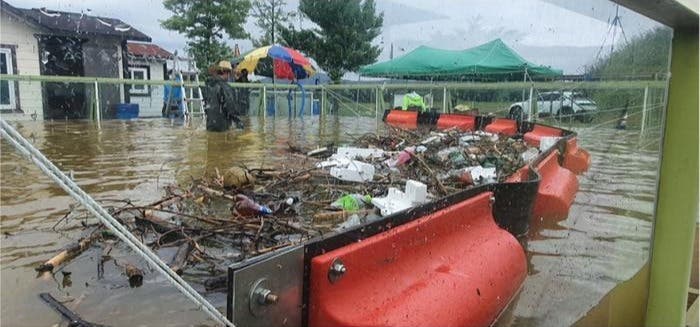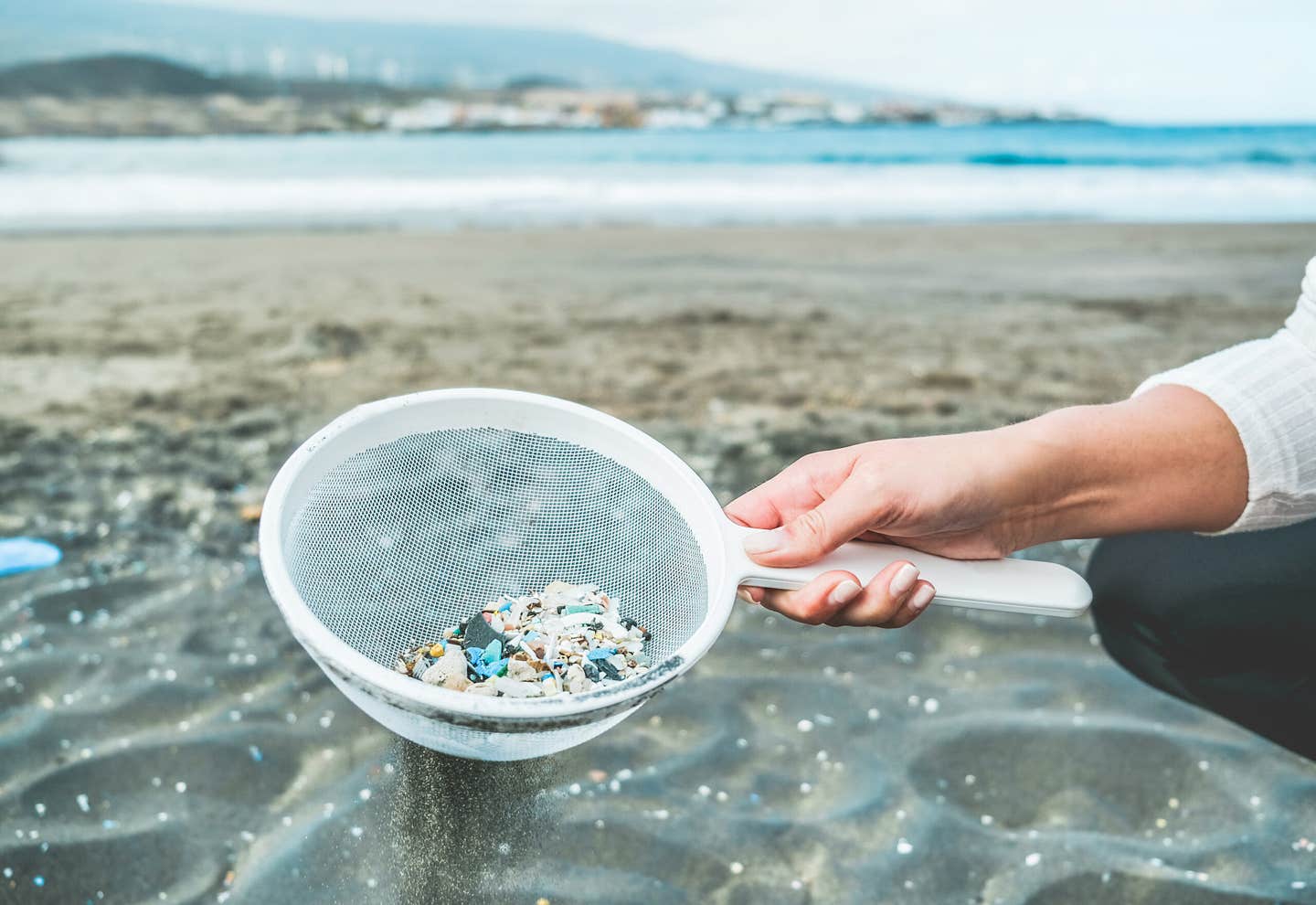Reviving our rivers: Newly developed floating trash interceptor cleans rivers and waterways
Marine debris has long been a pressing environmental issue, causing widespread pollution in the world’s oceans and seas.

[Dec. 7, 2023: JJ Shavit, The Brighter Side of News]
To enhance the real-world applicability of the AI analysis technology, image data from square basin and full-scale experimental channel were obtained and utilized. (CREDIT: Korea Institute of Civil Engineering and Building Technology)
Marine debris has long been a pressing environmental issue, causing widespread pollution in the world's oceans and seas. Recognizing the urgency of this problem, researchers at the Korea Institute of Civil Engineering and Building Technology (KICT), under the leadership of President Kim Byung-suk, have undertaken a pioneering initiative to tackle this issue at its source - rivers.
Their innovative technology aims to reduce floating debris in rivers, thereby preventing it from reaching the open sea and exacerbating marine pollution.
The Significance of Marine Debris Reduction
Rivers serve as primary conduits for land-originated marine debris to enter the oceans, making them critical points for intervention. In response, Dr. Sang Hwa Jung and his research team at KICT embarked on a groundbreaking project that brought together local governments, citizens, and experts in a collaborative living lab setting. Their goal was clear: to develop a cutting-edge interceptor facility that would not only mitigate structural vulnerabilities but also incorporate features for efficient collection, adaptability to fluctuating water levels, and real-time monitoring.
The River Experiment Center in Andong has three straight and curved experimental water channels with dimensions of 700m(L)*11m(W)*2m(H), and operates a laboratory for empirical testing of dike failure and urban flood defense technologies. (CREDIT: Korea Institute of Civil Engineering and Building Technology)
Chungcheongnam-do (Chungnam), a province in South Korea, possesses the third-longest coastline in the country, crisscrossed by a network of 500 rivers and streams. Over the years, the amount of marine debris in Chungnam has been steadily rising, with approximately 61.2% of it entering the sea via these rivers. In 2019, Chungnam installed an interceptor facility, but it suffered structural damage during heavy rainfall and flooding events. The root cause of this failure was the inadequate consideration of the river's unique characteristics, such as water level, width, flow rate, and water level fluctuations.
The KICT-led project had two primary objectives. First, it aimed to ensure the structural integrity of the interceptor facility. Second, it sought to develop and test an interceptor system that could provide seamless collection support, adapt to changing river conditions, and enable real-time monitoring to optimize debris collection timing.
Business potential assessment for developing floating debris barrier module & prototype development. (CREDIT: Ministry of SMEs and Startups, 2017)
Dr. Jung's research team executed their project in several stages:
Characterization of the Target River: Comprehensive studies were conducted to understand the unique features of the target river, which were vital for the interceptor facility's design and construction.
Selection of Optimal River Points: Careful selection of the ideal points along the river was essential to maximize the system's efficiency.
Design of the Barrier, Support Piles, and Connections: Engineers collaborated with Foresys Co., Ltd. to design the interceptor facility, ensuring it was tailored to the river's characteristics.
On-Site Construction: The interceptor facility was constructed in Gongju, Chungnam, on the Yugu-cheon (Yugu Stream), marking a significant milestone.
The River Experiment Center in Andong, Gyeongsangbuk-do, played a crucial role in this endeavor. Covering an impressive 192,051 square meters, this facility boasts South Korea's most extensive testing infrastructure. With a flow supply capacity of up to 10 cubic meters per second, it provided an ideal environment for empirical testing.
In May 2023, the interceptor facility on Yugu-cheon became operational, marking the culmination of the project's efforts. To ensure optimal functioning, a monitoring system was integrated, designed in consultation with local governments. This system allows authorities to determine the most opportune times for debris collection and access real-time information on the facility's performance.
Related Stories
One of the standout features of this project is the development of an AI-based support system. Leveraging image data collected through monitoring, this system employs artificial intelligence to analyze the quantity and composition of floating debris in the river. This analysis, in turn, informs the appropriate collection cycle, enhancing the efficiency of debris removal efforts.
Dr. Jung emphasized the critical importance of intercepting and collecting debris from rivers before it reaches the sea. He pointed out that marine debris in the open ocean is challenging to collect due to its wide dispersal and the presence of impurities such as salts and mud. These factors significantly increase the cost and complexity of cleanup operations. By integrating traditional river engineering with advanced technologies like information technology and AI, Dr. Jung's team has provided a practical solution that addresses both local and global environmental challenges.
Local and Global Implications
The project's approach, rooted in living lab-based convergence technology development and sustainability, has garnered significant attention and anticipation within the local community. The interceptor facility and monitoring system at Yugu-cheon will remain in operation and subject to continuous improvement until 2026. Discussions with relevant local governments are already underway to extend the project's success to other rivers, promising a far-reaching impact on environmental conservation.
Demonstration of Operation Management System of Land-based Debris Barrier System on IoT(Ministry of Land infrastructure and transport, 2022-2023). (CREDIT: Foresys)
The development and implementation of the interceptor facility in Yugu-cheon, Chungnam, represents a significant stride in the fight against marine debris. By addressing the problem at its source - in rivers - researchers have crafted a proactive solution that prevents debris from entering the sea in the first place. This innovative approach, combining engineering expertise with cutting-edge technology, showcases the potential for addressing global environmental challenges through local action.
As Dr. Sang Hwa Jung and his team at KICT continue to refine their technology and collaborate with local governments, their project sets a remarkable precedent for tackling marine pollution. By embracing the power of convergence technology and sustainability, they have shown that effective solutions to complex environmental problems can be found through innovation, dedication, and a commitment to protecting our planet's delicate ecosystems.
For more science and technology news stories check out our New Innovations section at The Brighter Side of News.
Note: Materials provided above by The Brighter Side of News. Content may be edited for style and length.
Like these kind of feel good stories? Get the Brighter Side of News' newsletter.



